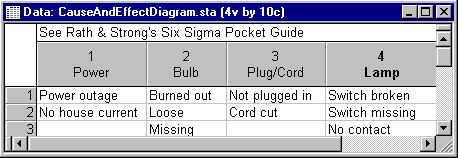Process Analysis - Cause-and-Effect Diagrams
The cause-and-effect diagram provides an efficient summary of factors that impact a process, and hence can be used as a map to guide the overall quality improvement efforts. Therefore, it is one of the important tools for the Define phase of Six Sigma quality control efforts. The diagram is also sometimes referred to as "fishbone chart," because of its appearance, or Ishikawa chart. The latter name refers to the work of Professor Kaoru Ishikawa of Tokyo University who developed this diagram to depict variables that are present in a process (the Japanese name for the diagram is Tokusei Yoin Zu - characteristics diagram; see also Seder, 1962).
The general idea of the chart is rather straightforward. Suppose you want to turn on a reading light in your house one evening, and it won't light up. Now consider the various variables or characteristics that make up the process (cause the light to come on), and that should be considered in order to fix this quality problem:
The cause-and-effect diagram shown above (adapted from Rath & Strong's Six Sigma pocket guide, 2000) spells out the various potential causes of the problem encountered. Usually, the chart is constructed by identifying 1) the major categories of causes that affect the process (in this example Power, Bulb, Plug/Cord, and Lamp), and 2) the individual factors or causes that can be classified into these major categories (e.g., Power outage, No house current, etc.). You could now use this map as a guide to troubleshooting the problem you encountered turning on your reading light. You can also further "augment" this chart (using the custom drawing and other tools of Statistica graphics) by adding various sub-sub causes, causes that you ruled out, solutions you have tried, etc.
In practice, in order to develop a cause-and-effect diagram, Pyzdek (1989) recommends to follow these steps (Pyzdek, 1989, p. 113):
- Develop a flowchart of the area to be improved.
- Define the problem to be solved.
- Brainstorm to find all possible causes of the problem.
- Organize the brainstorming results in rational categories.
- Construct a cause and effect diagram that accurately displays the relationships of all the data in each category.
Once these steps have been completed, transfer the major categories of causes and the sub-causes to the chart as major arrows ("fishbones") and subheaders (of course, the Cause and Effect procedure of Statistica Process Analysis will do this for you).

